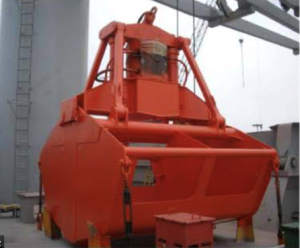The Charity
Aviation
Maritime
M1908

Initial Report
[Note: CHIRP received this report from a company who were happy to share their safety learning. CHIRP applauds their transparency and commitment to safety and welcomes reports from other similarly-minded organisations.]
A three-person crew had been tasked to replace the wire rope of a cargo crane grab stowed on the main deck in its designated storage position. The weather was fair, and working at height precautions, including completing a Permit to Work, had been taken.
The work started in the morning and was completed in the evening. Two seafarers first descended from the grab. The senior crew member then unclipped his safety harness as he prepared to descend. Tragically he lost his footing and fell about 5 metres onto the platform railing and a further 1 metre onto the deck below. He suffered a head injury and was taken to the ship’s hospital. The ship’s master sought radio medical advice, but the crewman died of his injuries about an hour after the accident.
The grab’s shape, size and position meant poor hand and footholds, although it was concluded that the crew member probably perceived the risk involved as acceptable and within his control. The fall prevention equipment on board was not ideal for vertical movements, so using equipment such as a double-legged energy-absorbing lanyard would have been more appropriate. The equipment was of a type that necessitated unclipping the safety harness lanyard to ascend or descend at the work site.
The ship’s SMS procedures did not refer to hazards related to access/egress from a worksite at height, and it could not be determined if the risk of going up and down from the grab had been assessed.
CHIRP Comment
The task was lengthy and required concentration throughout, which can bring about fatigue. When we finish a job, particularly one that is challenging or difficult, our brains release dopamine which causes positive feelings but can also impair decision-making, including when assessing risks. In combination, these factors would make the descent from this task perhaps the riskiest part of the job.
A fatigue management plan is useful in these circumstances: if a task can be broken into smaller parts, and either sufficient rest breaks or crew rotations are provided, then concentration and decision-making can be protected.
The company have suggested that a double-legged energy-absorbing harness would have been appropriate. CHIRP agrees, because a single-leg harness must be unclipped when climbing, descending, or navigating obstacles, thus removing the benefit of wearing a harness. And in this incident, a fall arrestor would not have worked because the crewman would hit the grab or the deck before it functioned.
Were the placement of hand-holds or other safe means of access considered at the equipment’s design stage? If not, why not? Some vessels have fold-away temporary scaffolding that can be quickly erected around equipment. This takes up minimal deck space and is relatively cheap.
Key Issues relating to this report
Teamwork– Supporting one another is crucial during high-risk work which is long and physically demanding. Is this the case on board your vessel or in your company? Do you feel supported by your ship workmates, or do you operate like an individual with everyone doing their own thing?
Alerting- If you see a team member’s performance dip due to fatigue, do you feel empowered to point it out and take a short break?
Fatigue- The task started early morning and finished early evening. Regular breaks should be incorporated into lengthy tasks and, if necessary, the task should be broken into smaller tasks spread over several days. Team members should also be monitored for signs of fatigue. Fatigue management planning should take these factors into account.
Fit for purpose (equipment)– CHIRP recommends that safety harnesses have two lifeline lanyards (also known as double-lanyard harnesses) so that at least one can always be connected when climbing up or down a ladder. For wearers of harnesses fitted with only one lanyard, the ascent or descent to a task is the most hazardous time.
This data type is not supported! Please contact the author for help.






